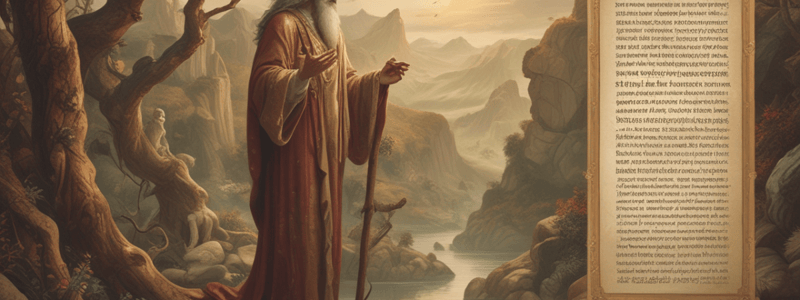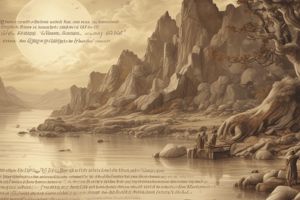Podcast
Questions and Answers
What percentage of the Bible is written in poetic form?
What percentage of the Bible is written in poetic form?
- Over 50%
- Over 40%
- Over 30% (correct)
- Over 20%
What does imagery help to describe in biblical poetry?
What does imagery help to describe in biblical poetry?
- Concrete objects
- Intangible experiences, like emotions (correct)
- Tangible physical experiences
- Abstract concepts
What do metaphors map in biblical poetry?
What do metaphors map in biblical poetry?
- Basic concepts onto abstract concepts (correct)
- Intangible experiences onto concrete objects
- Abstract concepts onto basic concepts
- Concrete objects onto intangible experiences
What do biblical poets constantly use in their poetry?
What do biblical poets constantly use in their poetry?
What does 'chaotic waters' represent in biblical poetry?
What does 'chaotic waters' represent in biblical poetry?
What does God bring to the chaotic waters in biblical poetry?
What does God bring to the chaotic waters in biblical poetry?
What does 'dry land' represent in biblical poetry?
What does 'dry land' represent in biblical poetry?
What does the image of dry land symbolize in biblical poetry?
What does the image of dry land symbolize in biblical poetry?
What is the temple associated with in biblical poetry?
What is the temple associated with in biblical poetry?
What is the image of a high rock or mountain garden temple used to describe in biblical poetry?
What is the image of a high rock or mountain garden temple used to describe in biblical poetry?
Flashcards are hidden until you start studying
Study Notes
Understanding Biblical Poetry
- Over 30% of the Bible is written in poetic form, which uses creative imagery and metaphorical language to convey ideas and invite imagination.
Imagery and Metaphor in Biblical Poetry
- Imagery helps to describe intangible experiences, like emotions, by linking them to tangible physical experiences.
- Metaphors map basic concepts (e.g., warmth) onto abstract concepts (e.g., affection), providing a more imaginative way to talk about experiences.
- Metaphors govern our thinking and language, and the metaphors we use shape our imaginations and behavior.
Biblical Poets' Use of Metaphors
- Biblical poets constantly use metaphorical imagery, which can be easy to understand (e.g., "light is good" and "darkness is bad") or seem strange to us due to cultural differences.
- Examples of metaphors include "chaotic waters" representing danger and chaos, and "dry land" representing safety, security, and stability.
Chaotic Waters and Divine Power
- In biblical poetry, chaotic waters symbolize danger and chaos, while God has the power to control and bring order to these chaotic waters.
- This metaphor appears in Psalm 69 and Isaiah 17, where God saves and controls the raging waters.
- The image of chaotic waters is introduced in Genesis 1, where God brings order to the dark, chaotic ocean, and develops throughout the Bible.
Dry Land and Divine Presence
- Dry land, in contrast, represents safety, security, and stability, which are fundamental human desires.
- In Genesis 1, God creates dry land, providing a safe space for humans, and plants the Garden of Eden, an ancient temple, high above the dangerous waters.
- The image of dry land and the Garden of Eden permeates biblical poetry, symbolizing God's presence and closeness to humans.
Temple Imagery and God's Presence
- The temple is associated with God's presence, and the image of a high rock or mountain garden temple is used to describe God's closeness to humans.
- This imagery appears in Psalm 65, where God's presence is celebrated in the temple, and in Psalm 18, where God is referred to as a rock and fortress.
Understanding Biblical Poetry
- Biblical poetry uses rich metaphors rooted in earlier narratives, which must be understood in context to reveal deeper meaning.
- Learning to read biblical poetry, such as the Book of Psalms, requires understanding the narratives that underlie the poetic images.
Understanding Biblical Poetry
- Over 30% of the Bible is written in poetic form, which uses creative imagery and metaphorical language to convey ideas and invite imagination.
Imagery and Metaphor in Biblical Poetry
- Imagery helps to describe intangible experiences by linking them to tangible physical experiences.
- Metaphors map basic concepts onto abstract concepts, providing a more imaginative way to talk about experiences.
- Metaphors govern our thinking and language, and the metaphors we use shape our imaginations and behavior.
Biblical Poets' Use of Metaphors
- Biblical poets constantly use metaphorical imagery, which can be easy to understand or seem strange to us due to cultural differences.
- Examples of metaphors include "chaotic waters" representing danger and chaos, and "dry land" representing safety, security, and stability.
Chaotic Waters and Divine Power
- In biblical poetry, chaotic waters symbolize danger and chaos.
- God has the power to control and bring order to these chaotic waters.
- This metaphor appears in Psalm 69 and Isaiah 17, where God saves and controls the raging waters.
- The image of chaotic waters is introduced in Genesis 1, where God brings order to the dark, chaotic ocean, and develops throughout the Bible.
Dry Land and Divine Presence
- Dry land represents safety, security, and stability, which are fundamental human desires.
- In Genesis 1, God creates dry land, providing a safe space for humans, and plants the Garden of Eden, an ancient temple, high above the dangerous waters.
- The image of dry land and the Garden of Eden permeates biblical poetry, symbolizing God's presence and closeness to humans.
Temple Imagery and God's Presence
- The temple is associated with God's presence.
- The image of a high rock or mountain garden temple is used to describe God's closeness to humans.
- This imagery appears in Psalm 65, where God's presence is celebrated in the temple, and in Psalm 18, where God is referred to as a rock and fortress.
Understanding Biblical Poetry
- Biblical poetry uses rich metaphors rooted in earlier narratives, which must be understood in context to reveal deeper meaning.
- Learning to read biblical poetry, such as the Book of Psalms, requires understanding the narratives that underlie the poetic images.
Studying That Suits You
Use AI to generate personalized quizzes and flashcards to suit your learning preferences.




